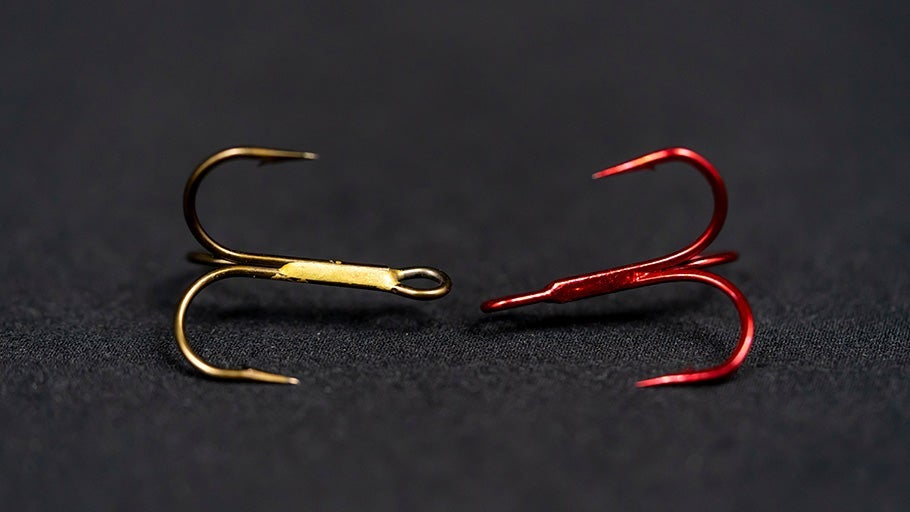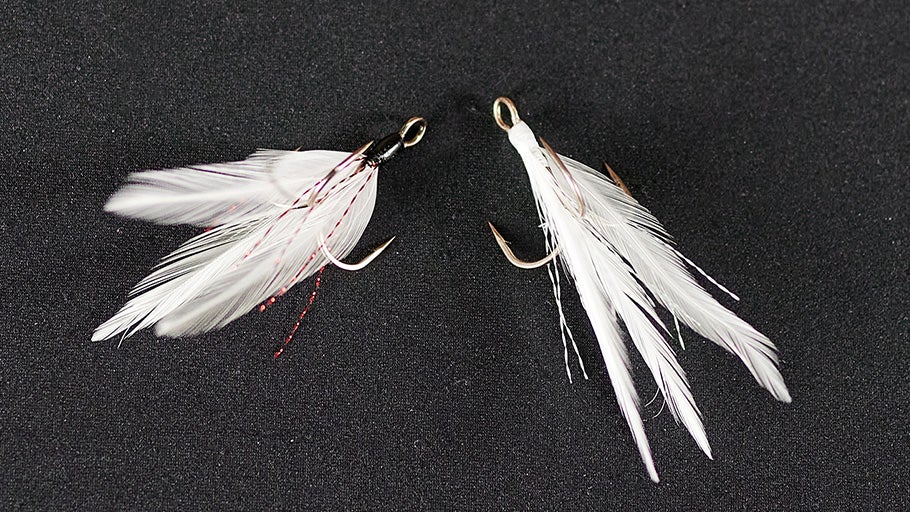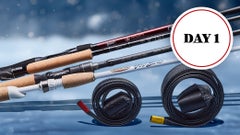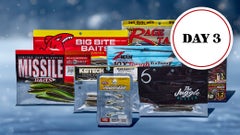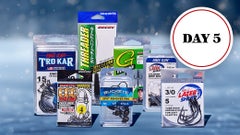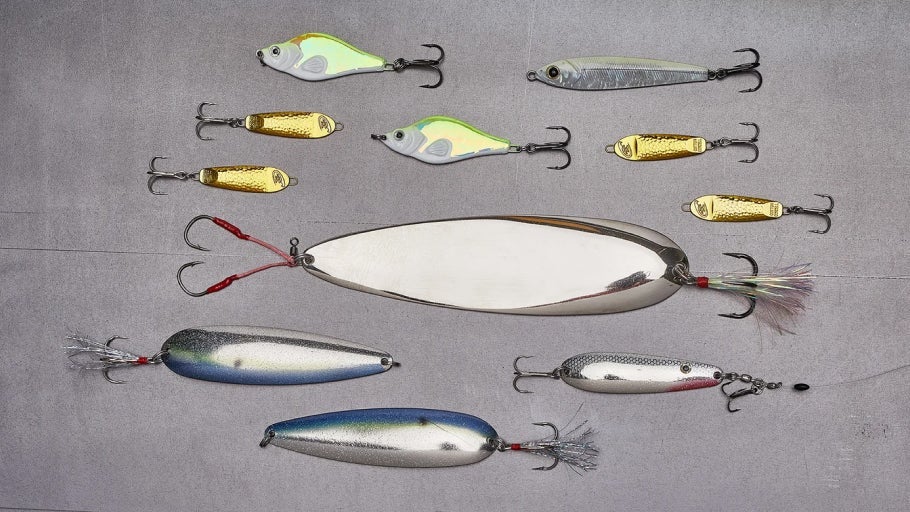
Blade Baits and Tail Spinners Gear Guide
Designed to trigger bites from lethargic, deep-water bass, blade baits and tail spinners are a coldwater duo capable of unlocking exciting bites when fishing slows down in the winter. Sharing a simplistic design that’s extremely effective at mimicking baitfish, these timeless lures have a rapid sink rate that allows them to reach fish quickly, even in the deepest water. Highly effective throughout the fall transition and into the dead of winter, blade baits and tail spinners make a unique addition to an angler’s tacklebox when the fish are pressured and have seen tons of other baitfish imitators. In this Gear Guide, we’ll go over all the best equipment to effectively fish a blade bait or tail spinner, dive into modification and rigging methods, and analyze various retrieve techniques so you’re prepared to hit the water with confidence!
Blade Bait & Tail Spinner Rods
The ideal blade bait or tail spinner rod is going to depend on the weight of the lure, the depth you are targeting, and angler preference. For 1/4oz or 3/8oz blade baits and tail spinners, your favorite 7’ – 7’6” fast tapered finesse spinning rod provides the ideal power and bend for firing casts with lightweight lures and capitalizing on bites from lethargic fish. When using heavier lures in the 1/2oz to 1oz weight class or fishing extremely deep, it may be less strenuous and more convenient to work the lure with baitcasting tackle where the added leverage from a casting rod reduces stress on your body throughout a long day of fishing.
Blade Bait & Tail Spinner Reels
If you opt for a finesse blade bait or tail spinner, consider using a 1500-3000 size spinning reel to improve handling with lightweight lures, being sure to choose a size that holds enough line to reach your target depth. Alternatively, if you’re trying to access deeper depths or use heavier lures, a low-profile casting reel in the 100-200 size with a smooth starting drag allows you to easily palm the reel and ensure positive hooksets when using treble or double frog hooks.
Blade Bait & Tail Spinner Line
If you plan on using spinning tackle, we recommend using a 10-15lb braided mainline to an 8-15lb fluorocarbon leader to give you the best combination of strength, sensitivity, and translucency. The no-stretch attribute of braided line provides added control when fishing deeper, encouraging more response and feedback through your fishing line so you feel more connected to the bait. With baitcasting tackle and heavier lures, a 20-40lb braided line to a 10-17lb fluorocarbon leader gets the job done, but you may consider using straight fluorocarbon around pressured fish or when fishing deeper with a lot of line in the water.
Modifications & Rigging
Whether you’re fishing in open water conditions or areas prone to frequent snagging, you may consider swapping out the stock treble to a more weedless style hook on your blade baits and tail spinners to reduce the chances of snagging. A single belly treble hook design commonly found on most tail spinners allows the hook to lay flat against the body, so it remains relatively weedless when fished around the lake bottom. By contrast, the double treble hook configuration of a blade bait often presents issues around snaggy cover, so experiment with the use of a double ‘frog-style’ hook to improve efficiency when fishing around challenging structure.
Most blade baits, and some tailspins, are built with multiple snap/line tie locations so anglers can easily adjust the pitch of the blade to match the mood of the fish throughout a day of fishing. By using the forward snap location, the blade vibrates subtly with tight-pitched action for less wobble and a more natural appearance in clear water conditions. The ‘standard’ or middle snap setting location creates moderate vibration perfect for vertical and all-purpose fishing applications. As you adjust the snap towards the back of the bait the blade creates a heavy wobble, tons of feedback, and the most vibration for ideal for dirty or stained water situations.
Due to their fixed position on the thin metal body of a blade bait, split rings are subject to binding up as they twist and rotate during a fight, potentially creating leverage for fish to throw the hook. To improve landing ratios and make your presentation more silent around pressured or spooky fish, experiment with using a 40-80lb braided line as split rings to attach your preferred hook directly to the bait. Opening up a small metal split ring with pliers can often damage them as well, so the high-strength and flexible attributes of braid not only allow the hook to spin with less restriction but also ensure they do not fail over time.
Retrieve Techniques
Blade baits and tailspins sink faster than most lures in your tacklebox, to give anglers the unique ability to reach deep-water fish rapidly as they appear on Live, DownScan, and 2D Sonar. When fishing vertically, tail spinners and blade baits provide pinpoint control and sink rate to quickly target fish residing anywhere in the upper, middle, or bottom sections of the water column.
Anglers using electronics can start by positioning the boat over schools of baitfish to see how the fish are positioned, drop lures to marks on the screen, and use short twitches of the rod tip to get the blade moving while being mindful to not overwork the bait in the strike zone. These lures remain effective without the need for fancy electronics, as anglers can simply cast and retrieve, impart yo-yo action, or stop-and-go retrieves commonly used with lipless crankbaits.
The fall and winter are seasonally great times of the year to break out the blade bait or tail spinner, but their slight variation in construction is what makes one excel over the other when you’re faced with a tough bite. A tailspinner is a piece of lead with a treble hook, a line tie, and a spinning rear blade that’s ideal when you want a smaller baitfish profile to increase appeal or need to sink the bait quickly to a target. While the thin bladed construction of blade bait is often the better choice for dirty water situations when increased vibration is needed to attract fish from greater distances.
Colors
Blade baits and tail spinners have a compact profile that’s typically used to mimic baitfish, so it's best to keep things simple by sticking to shiny colors like chrome and gold or white and shad variations that mimic the forage in your local waters. When selecting a color, you also want to consider seasonal factors, as red-colored blade baits that mimic crawfish often become extremely productive during the early Spring when the water temperature is still cold. Water clarity is another factor that determines color choice, as you’ll want to focus on natural colors in ultra-clear water conditions and use bright colors like white or chartreuse when faced with dirty water.
Often overlooked by modern-day anglers, blade baits and tail spinners are vastly underrated and versatile lures for pairing with forward-facing sonar, and are possibly the most effective baits to fish when the fishing slows down, and the bass go deep in the winter! Be sure to check out our Jigging & Flutter Spoon Gear Guide for more tips and tricks for deceiving finicky bass in similar situations.
Related Articles

